With this basket of assorted pure rye breads I wish to tantalize your taste buds and tease you with these pure sourdough rye:
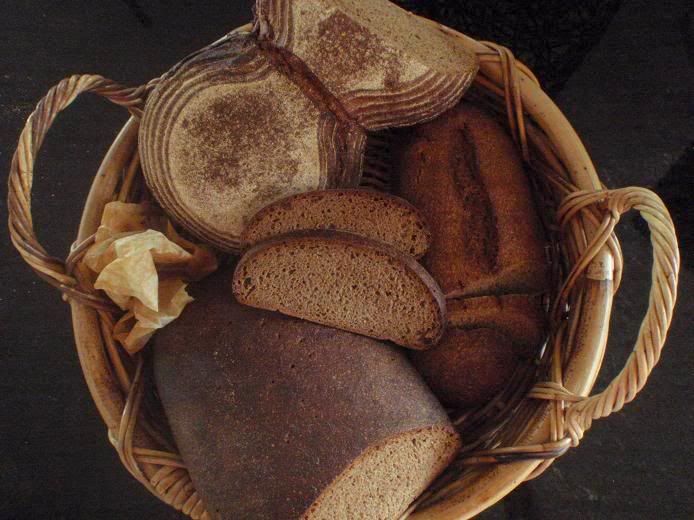
[color=brown][b]Assorted pure rye breads[/b][/color]
[u]Centre bottom[/u]: Sour Rye, year 1939 (recipe from Mariana-aga's most informative and beautiful post on Russian rye [b]here[/b])
[u]Right[/u]: Jan Hedh's Sour 100% Rye Bread (recipe from Dan Lepard's [i]The handmade loaf[/i], page 31)
[u]Top[/u]: Detmolder Three-Stage 90% Sourdough Rye (recipe from Hamelman's [i]Bread[/i], page 201)
Like most Asians, I have not grown up with rye, an acquired taste, many would admit. I am from an area of the Chinese world where "fish and rice, and other luscious colors of food exist," as the saying goes. My parents would think very little of rye. You may have already been a convert but it took me a lot of efforts. As Dan Lepard says of rye bread, "What was once the bread of the poor has become the staple of the rich man's table" ([i]The handmande loaf[/i], page 66), I am excited that finally I have had a glimpse into what some bakers are passionate about. I hope that, with the following photos taken from my kitchen table, you will share my enthusiasm.
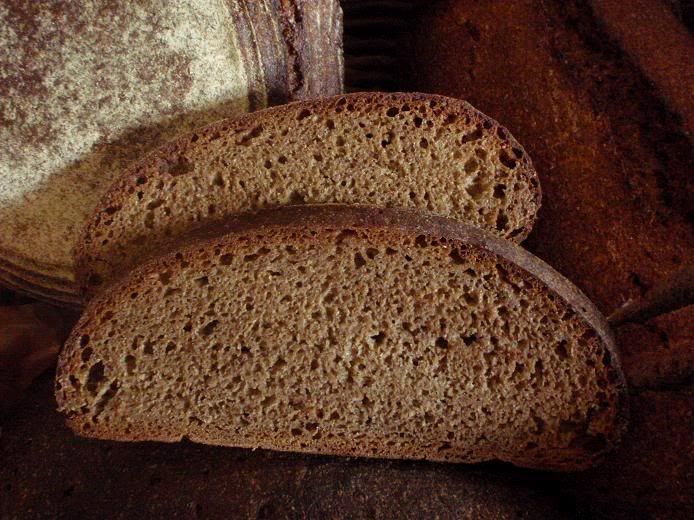
[b]A close-up shot of Sour Rye, year 1939, a lot of soul.... I must be imagining.[/b]
[color=red][b][u](1) Sour Rye, year 1939[/u][/b][/color], from Mariana-aga's blog post [b]here[/b].
- 350 g ripe 100%-hydration rye levain
- 420 g medium rye flour
- 308 [b]warm[/b] water
- 14 g salt
- Rye starter: 83% baker's percentage
- Prefermented flour: 29% of total flour
- Overall hydration: 81%
- Fermentation: 2 hours bulk + 35 - 50 minutes proof
- Total dough weight: 1,090 grams
Refer to Mariana-aga's link above for method. I used Google to translate Russian to English. The translation does not always make sense, but does the job alright. Where you find gaps, you can fill them in with your own imaginations.
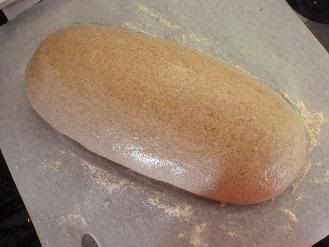
The instruction says you smooth out the surface of the dough with wet fingers "frequently." Whenever I saw "cracks" developing on the crust, I smoothed them out with wet fingers and/or my plastic scraper dipped in water. I ended up doing this every 20 minutes or so throughout the fermentation. I covered the dough with a big roasting pan.

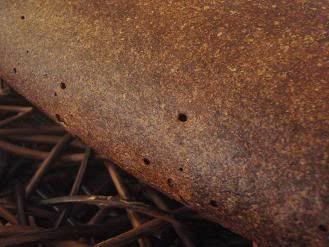
The style of this bread is unlike anything I've made before. I asked my son how he liked the bread in the picture. Instead of saying he finds it unattractive, he politely asked where I got this strange looking basket. I said from a garden and plants nursery. I used to do a lot of flower arrangements and I have my fair share of strange looking vessels.


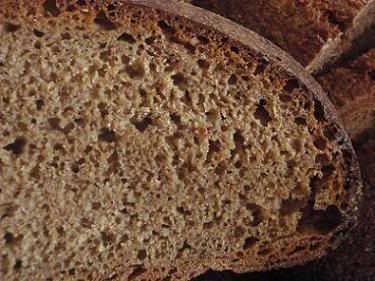
A mate of my husbands, who comes regularly for morning coffee, was here the day before yesterday when I was slicing this bread after it had rested for 24 hours. The first thing he said after having a piece was, "This sourdough rye is sour and tangy!" AND, he liked it very much. I had a couple of thin slices myself with butter. Very tasty and moist. I surprised myself. It is medium strength sourness, very pleasant. I think that the flavourfulness comes through in the crumb shots above and below quite well.

I like this bread the most out of the three pure rye breads pictured in the basket above. The reason why this is so is because this bread was the last one out of more than half a dozen pure rye breads that I made over the last two weeks - my rye starter up to that point was full of vigour and had developed a lot of flavors when I used it to make the bread.
[color=red][b][u](2) Jan Hedh's Sour 100% Rye Bread[/u][/b][/color], from Dan Lepard's [i]The handmade loaf[/i], page 31.
- Rye starter: 67% baker's percentage
- Prefermented flour: 35% of total flour
- Overall hydration: 85%
- Fermentation: no bulk + 5 hours proof
- Total dough weight: 850 grams
According to Dan Lepard, Jan Hedh has inspired the new generation of artisan bakers in Sweden. Dan's book has lots of wonderful formulas and stories, but the book's unassuming appearance and colorful pictures are perhaps too easy going for the serious home bakers. I don't seem to see a lot of his recipes being used here. I find his book a seriously good book.

This formula is interesting in that it uses a gelatinized rye mix (4 parts boiling water to 1 part rye flour). Not just it gives elasticity to the crumb, it also makes the bread very moist and as a result, the bread has even a better keeping quality than the other two breads. Chinese use a similar gelatinized flour mix called "65 degree C dough" with similar flour to hot water ratio and for similar purposes.
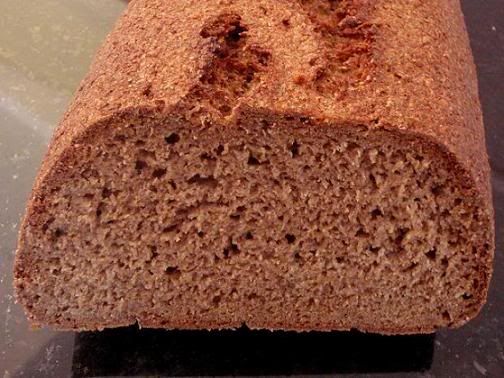
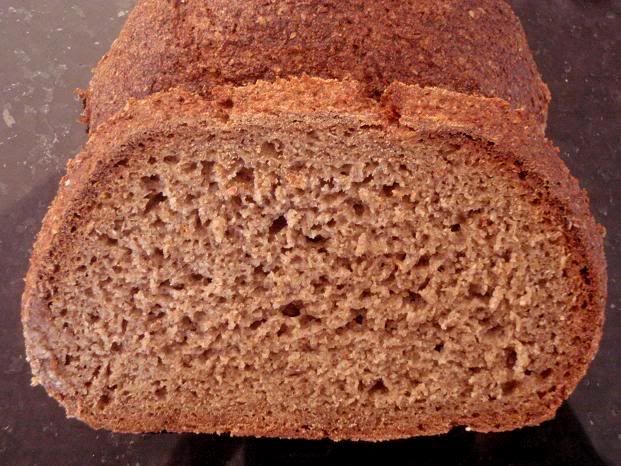
(Note: the above two shots were taken at night time. The reddish tone is due to the yellow spot light in my kitchen and is not reflective of the real color.)
[color=red][b][u](3) Detmolder Three-Stage 90% Sourdough Rye[/u][/b][/color], from Hamelman's [i]Bread[/i], page 201.
- Rye starter: 119% baker's percentage
- Prefermented flour: 38% of total flour
- Overall hydration: 79%
- Fermentation: 20 minutes bulk + 1 hour proof
- Total dough weight: 1,640 grams
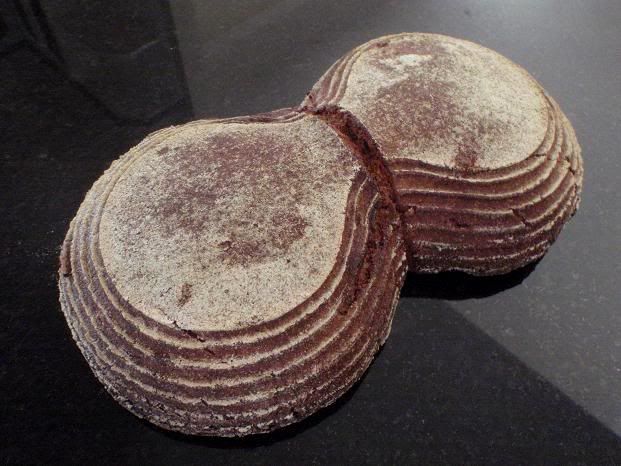
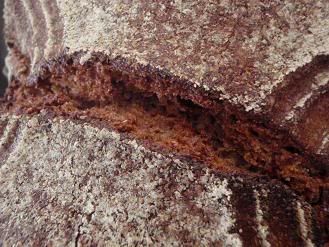

This was my second try on the Detmolder formula.
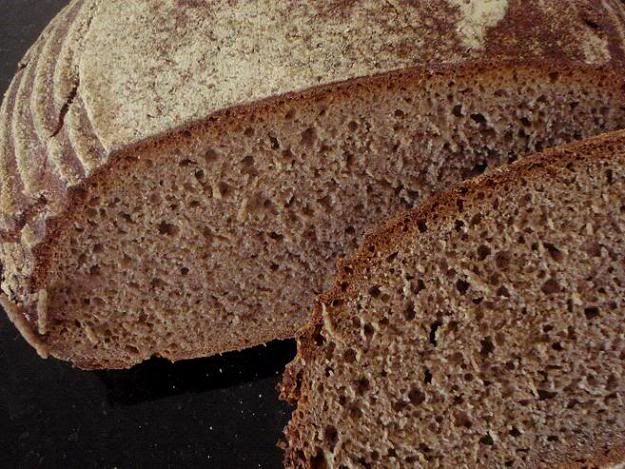
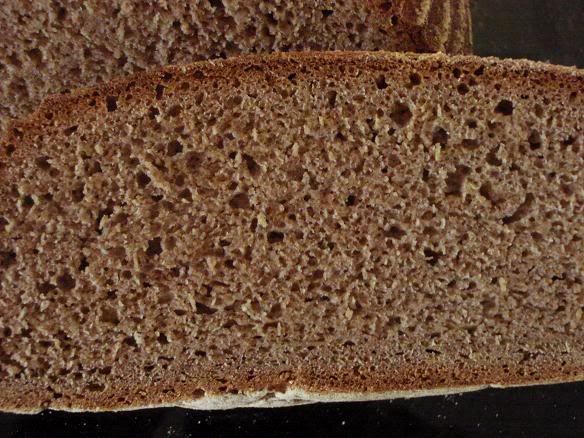
My Detmolder sour rye was made before the first two breads in this post above and is not as tasty as those two breads. One possible explanation is that my rye starter used in this bread was not as robust to start with.
Two days after I made this Detmolder bread, I made it again - my third try in five days. Talk about a keen baker! I did it again not because I wanted to see how I could improve on this bread, but more because I wanted to keep feeding my rye levain and I didn't want to throw the excess out. You wouldn't believe what happened - as I tried to turn the proved dough onto my peel, half of the dough fell out while the other half stuck to the banneton. A disaster! I told myself, Calm Down. I gathered the dough fragments together, reshaped it, and put it back to the banneton. An hour later, when I tried to turn it out again, the exact same thing happened! At that point I was in two minds about whether I chuck it or bake it. In the end I decided that either way it is a goner, and so why not do an experiment with it and watch the show. I recalculated my ratios and added some more water to change the dough to a 100%-hydration dough. I put it into a loaf tin this time. I wanted to see what would happen to the dough with this much hydration and supported by a loaf tin. Well, I had the most spectacular oven spring ever with pure rye dough (well, 90%, almost pure)!
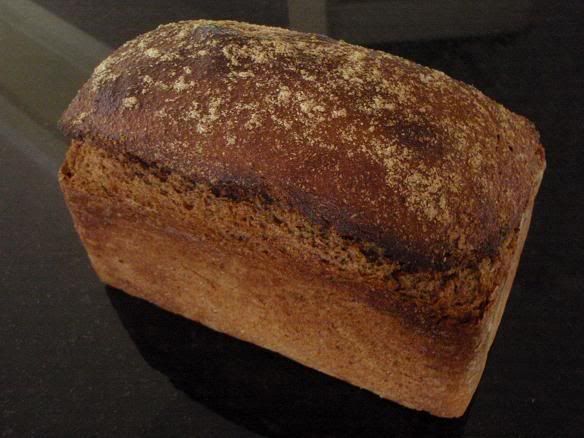
Detmolder 90% Rye @100% hydration and 6 hr fermentation (not pictured in the bread basket above)
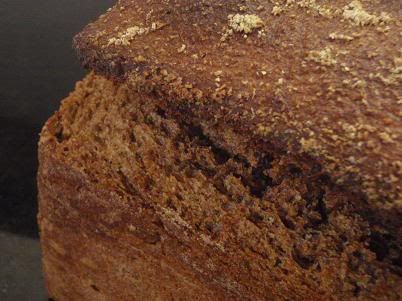
By the time the dough was in the oven, what was supposed to be fermented for only one hour and 20 minutes had gone through a six-hour fermentation. I was amazed at the amount of oven spring. I am sure this has to do with the 100% hydration. It had risen about 30% before it went into the oven, then in the oven it rose another 70 - 80%. The crumb was quite open - you cannot [b]not[/b] have an open cell structure with this much oven spring. The gumminess on the top and bottom edges of the slice pictured below is the "starch attack" due to excessive amylase activity that caused the break down of the dough structure during the bake, I guess.
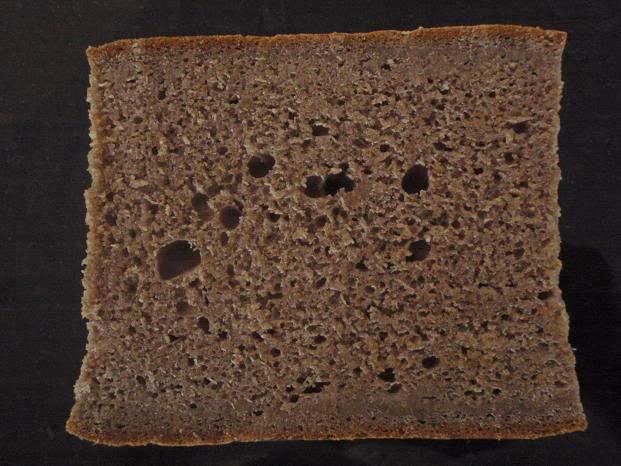
The dark, almost chocolate, color in the crumb is natural. It is achieved through the long fermentation. I haven't seen a [b]natural[/b] dark rye color like this before!
And the taste? Well, unpleasant, to say the least! It has a pungent pickled sour taste, almost like when the pickle is off. Neverthelss, this experiment has got me excited about an idea for my next pure rye bread experiment along these lines:
- 30% prefermented flour
- Rye starter 80% bakers percentage
- 100% overall dough hydration
- 3 hours (or shorter) fermentation, assisted with, say, 05% IDY
[b][u]To recap[/u][/b]: the 1939 Sour Rye is the most flavorful because the rye starter was at its best condition when the dough was mixed and also because I took more care with the dough. Jan Hedh's Sour Rye is the most moist because of the gelatinized rye mix that is incorporated in the dough. Overall, I like all three breads pictured in the basket above.
I have but one complaint: that their crusts are too tough to cut; you need a chain sword to slice the bread. The tough crusts are a result of the long bake which I am told that you need for this particular type of flour. The average baking time for a 1 kg dough according to both Mariana-aga and Hamelman is one hour at initial high heat of 250 - 260 C for 10 - 15 minutes, then gradually lowering the heat to 200 - 210C. My Thiezac pure rye bread, on the other hand, was 1.8 kg and I baked it for only one hour and it was perfectly cooked. So I don't know. The Thiezac bread was far easier to slice.
I am ending this post with another bread basket but this time with the breads all wrapped up in thick tea towels:
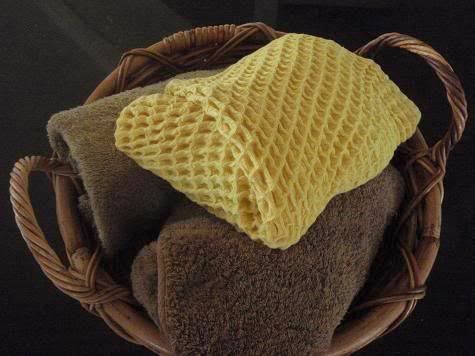
I am going to enjoy these three breads over the next week or two and observe the changes in tastes and flavors. Rye enthusiasts would be familiar with Hamelman's story where, as a young man in the 1970s, hiking the Long Trail through Vermont, he picked up the last of his food provision from a post office, a five-week old Detmolder Three-Stage 90% Sourdough Rye where the bread still [b]"had a crisp tang, a moist crumb, delicious flavor, and not a hint of mold."[/b] How extraordinary is that! I am not sure mine would stay like that after one week, or, rather, are like that to begin with, let alone after five weeks!
Shiao-Ping
- Shiao-Ping's Blog
- Log in or register to post comments
Hi nicodvb
My Google translator did say Very Hot Water. This is where we need to use our (liberal) judgment. How hot is Very Hot? And, would that NOT kill the yeast? Didn't they say the wild yeasts can take temperature up to 49-53C, and beyond that they die? So, Yes, Google did say Very Hot Water, but I put down in my post just "Warm water" - I am thinking something like our body temperature, 37C (99F) or so. I think anything above 30C (86F) would be fine. Most books say that rye dough should be fermented in relatively high room temperature, like 30C -32C.
As for the procedure why don't we wait for the Russian translation and I can fill in with my experience.
Hello, Shiao-Ping. I'm late to this discussion, but as I read through the posts I didn't see a clear answer to your questions about the recipe. The water is supposed to be "very warm" and final dough temp is 30 degrees C. The flour is whole rye, not "wallpaper" :). The salt is dissolved in water to ensure thorough distribution, since the dough is not kneaded much. The dough is fermented at 30 deg. C for 2 hours, then shaped with wet hands into loaves. Proofing is 35-50 mins or until it doubles, then a final smoothing of the surface with wet hands, then bake.
Your loaves look beautiful. I'm crazy about rye myself; probably because I'm Russian and was brought up on dark rye breads. Your willingness to give rye a chance is commendable.
Ana
for your synopsis of the procedure.
Shiao-Ping
Regarding water temperature, see my previous reply to your comment.
Also about the dough shaping, please see here. Sorry for the late reply.
Oh, I shaped the dough right after all ingredients are combined. Essentially the translation says 2 hour bulk fermentation and 35 - 50 minutes proofing, but I combined the two processes into one process. During the 2 hours & 35-50 minutes fermentation, my dough was about doubled.
So I went to the link that you have to the russian rye bread, Interesting it's all in Russian. Luckely for me I'm from there so read the whole thing. Thanks for the great breads, I'm baking some on Friday and will try to make some.
Hi, korish.
Since you are fluent in Russian and plan to make the bread yourself, perhaps you would translate the recipe correctly for the rest of us?
David
I have read the recipe in Russian and will try the bread probably this weekend, and I will translate it to English and share with you all with in the next week.
I also emailed Luba on here Russian blog asking her permision about translating some of her other breads.
That would be great help for all of us if you can translate the formula to English. Many thanks in advance!
Shiao-Ping
Did you mean to give the link to the Luba Russian blog? The link did not come through.
Thanks.
Shiao-Ping
No the blog that you provided. When you go to the details of the rigter it sais her name is Luba. I just mixed my ingredients together will probably bake in 2 hours.
Your breads are truly astonishing and picture perfect! Very inspiring and expertly done, Shiao-Ping! :)
Your breads look wonderful Shiao-Ping. I share your appreciation of the 1939 sour rye. That's a terrific loaf. Mariana is a baking genius indeed.
Eric
If I was ever a rye bread I should be one of your's, Beautiful! Fine crumb in rye is the standard here. The tough crusts will soften a bit inside a plastic bag.
If you want to freeze any of the ryes, I found it best when they are several days old after being bagged. The moisture is spread out that way in the crumb. If frozen fresh, they will thaw out with very hard outer crusts and moist middles. I also like to fold plastic wrap between the slices so I can separate easier and thaw out quicker as they lie flat. I use a thin very sharp knife to cut and not a bread knife or my electric slicer.
With less % of starter, and the same amount of proving, the starch attack wouldn't happen. I have to agree with you.
Mini
(1) Plastic bag: Great tip.
(2) Freeze after several days old in plastic bag: Great tip again.
(3) Plastic wrap beteen slices to freeze: Great tip again.
(4) Use very thin and sharp knife to slice (and no bread knife or electric slicer): Great tip.
(5) And the last one is the best tip of all: use less % of starter, I love it!
Shiao-Ping
(4) I use an electric slicer. I should have made a separate sentence.
Mini
... normally comes with serrated edge, so it is like a bread knife, isn't it?
And I have a serated bread knife in the drawer if ever I need it. Use it more on cakes.
Everytime I look at your pics of loaves 1 and 3, I get so hungry, they look so good! I can just smell them! I confesssss! With a great weekness (need it often) for rye! I want to just bite into them!
(Sing it) Rye Rye, Love; Rye Rye, Happiness; Hello loneliness, I think I'm a-gonna Ry-eye.
Mini
(but mine has different lyrics). Your song has a very good tune.
Shiao-Ping
The perfection of your loaves is fully expectible. I am more surprised you are acquiring a taste for rye! A courageous baker with a courageous palate!
David
David,
I am still in two minds about whether I have acquired a taste of rye. I think, while it sounds so good (I fall for anything that is [b]pure[/b]), pure rye (100% rye) is really hard to love, unless it is made very well. Last night my kids' god parents came for dinner. I toasted three kinds of my breads from the freezer for them to sample. One of them was my own version of Mathias Dahlgren Swedish Rye Bread with apple sauce. I tell you, this one is the best. It is so moist and full of flavor (of course, so much apple sauce was in there). Next time I would scale down the apple sauce and replace it with more water to keep the same hydration. It would be great. What I am saying is that I think pure rye, unless it is made really well, is difficult to love. I think with a bit of soaked grains and other soakers, the 100% rye would be more interesting and easier to love.
My next project, when I regain my energy, is rye in a modern outfit - rye in a summer dress - light, not the winter full-on heavy coat. I think rye can take on many faces.
Shiao-Ping
Hi Shiao Ping,
Thank you for your reply about the dry doughs eaten by Tibetans in the mountains. I apologise for not having had time to give a considered reply. Immediately it had me thinking of Russia selling its top class wheats on the world market as the people continue to consume rye bread. Also, what about the "rusk" that is used in the hot countries of Southern Europe? There is a Cretan salad of tomatoes where dried wholemeal bread is broken into pieces and left to soak up the juice from the tomatoes plus, of course, olive oil. It's biscuit of course; exactly how soldiers of the British Empire were fed.
Strange we are so obsessed with "freshness" now. So, how amazing to be able to bake bread which genuinely will stay moist for days and days without going mouldy!
I have just done some calculating, and have come up with the following as a near enough formula for the standard Russian Rye Bread we used to make; it looked remarkably like the tinned loaf you have photographed in your blog!
Material
formula [%]
recipe [grams]
Sour
5.6
3
Dark Rye Flour
37.2
20
Water
55.8
30
TOTAL
98.6
53
Rye Sour
93
50
Dark Rye
62.8
33.6
Salt
1.9
1
Water
29.2
15.4
TOTAL
186.9
100
Sour has 18 hours fermentation
Pre-fermented flour = 37.2%
Hydration = 85%
I hope this isn't too confusing for you: I have always listed my formula so that the total flour is 100%; that way you see at a glance what proportion is pre-fermented.
I would love to be spending as much time as you are on baking at home; so productively too. Great work!
Anyway, let me know what you think about this. Our recipe varied a lot over the years. Initially the sour was made with light rye which was mixed with boiling water to gelatinise the starch. This was then cooled and the old sour was added to this to make the ferment. Subsequently, the boil up was abandoned. The sour was then made with dark rye, but the final addition of flour was a combination of dark and light rye flour. As the interest in "wholegrain" took more hold we moved over to using solely dark rye in the whole formula.
Best wishes
Andy
Thank you for your information. Your standard Russian rye bread formula has rye sour almost 1.5 times (148.8%) the final dough flour (dark rye flour). May I enquire -
(1) How long did you ferment your final dough? I am guessing relatively short.
(2) For dough size of 500 grams and 1 kg, respectively, how long did you bake them and at what temperature?
(3) Given a standard size, do you bake your rye dough longer than dough with other types of flour because of the higher moisture content that rye retains?
Your point about modern day obsession with "freshness" in food is interesting. I sometimes think not everything that is old (or old-fashioned) is good. Sometimes the old way is what it is because they had no other way; it was through necessity, not through choice. But as far as rye goes, the old way seems to be a good way.
On the other hand, I have to say, in our modern era, less people are engaged in farming activity and labor where you do need to eat a lot for your strength. Pure rye bread does taste heavier than other type of breads. I think our modern diet favors lighter diet with more varieties, flavors and textures. My point is that light rye, instead of pure rye (100% rye, that is) is perhaps better suited for our modern diet.
Interestingly my neighbourhood has just had a new French-style village bakery open over the last couple of weeks. I was chatting with the French baker-owner the other day and the young chap said in France they do 50% rye and they are allowed to call it rye bread under their appellation control. He said anything more than 50% rye his customers don't want it.
Thanks and regards,
Shiao-Ping
Hi Shiao-Ping,
Firstly, the proportion of fermented flour in the formula. The owner of the bakery where I made all these loves liked his rye breads very sour; in his words "like sweaty socks"!!! Out of interest he used the sour at 50% as the basis for calculation of the formula, though I would disagree with this [see comments later in this paragraph] Of course you can reduce the amount of sour in the formula, no problem. So long as the formula balances with salt to your own taste and for functionality, and sufficient water to hydrate the flour you will be fine. Rye flour generally is so eminently fermentable; I would be happy to go down to about 10% and still expect success. Remember we used a very wet sour; I prefer to compare the flour content in the sour with that in the final dough to give a clearer picture. For our Rossisky loaf pre-fermented flour is 37.2%. I would happily quarter this and still expect successful fermentation. The obvious change, will be the length of time the final dough needs to ferment.
This relates directly to your second observation about final fermentation time. I would say between 1 and 2 hours only for the Rossisky loaves. There is no need for bulk fermentation time; I was just trying to find the discussion I saw on here relating to this, but no success. It might have been Eric or Hans, noting that a bulk ferment was not necessary as rye contains no elastic-forming gluten. If you went down to 10% then fermentation time would be 4-6 hours at my estimation. But that is fine, so long as you can look after your finished dough pieces carefully in the proof.
With regard to baking, yes you are right, the bake profile is somewhat different. Obviously ovens will vary, but in our rack ovens we baked the tinned loaves at 210*C, compared to standard wholemeal [wheat]tinned loaves at 235*C. The bake time for the large loaf was 50 mins compared to 35 for the wheat, and small loaves baked 35 minutes compared with 23. Scaling weights were 960 and 480g. These ovens had dampers on too, so we could allow steam to escape in the final portion of the bake so the loaves could dry and therefore bake better. One of few instances where I think convection ovens have an advantage over conduction!!! Yes, the long bake time is due entirely to the high moisture levels. Also, note that you have to address temperature issues again if your recipe calls for sweeteners such as molasses or malt.
Regarding freshness, and your note about the old way: here in the UK we have multitudinous food producers who are prepared to adulterate most of the food we eat with various "functional" additives. These may be chemicals, or enzymes, or other fancy formulae dreamed up in a science lab somewhere. I guess you know where I am coming from here. Loaves kept "fresh" by such means make up 99% of the bread eaten in the UK and it is truly woeful stuff. The beauty of naturally-fermented bread is the cultivated presence of naturally formed acidic bacteria which give the longer shelf life; this is true for wheat and rye, especially the high hydration sour doughs.
Yes, maybe our diet does need to be lighter given the change in working patterns. Some may advocate more need to get back to the land in order to sustain the planet for the future however!? That's another issue, and for now we remain relatively sedantry; although there are numerous ways to blast off energy in the gym, running, football etc. Also, there is a place for the heavy breads, we should just eat smaller quantities; that would be true of any type of food, yes? Personally I like the dark rye for the fibre content, but light rye does have a place to lighten the loaf; I would sooner use white wheatflour for this, see below. All this said, I agree with you that for everyday, most people would seek to eat a lighter bread; my staples are wheat-based Miche-style loaves, although the proportions of white and wholemeal will vary.
Bringing me neatly onto your ideas about mixing rye and wheat. I like to use a rye sour with wheatflour in the final dough. This is typically North European, and flavours such as Caraway and Molasses are wonderful. This is also what I think of as a French Pain Siegle.
Example formula could be something like this:
Rye Sour 60 [d rye 24 + water 36], Strong White Flour 76, Salt 1.8 and Water 27. You can make lovely miche-style loaves with this type of formula. But then you are back into the realms of bulk fermentation to allow the gluten in the white flour time to soften and become extensible.
Having said all this, I only have one culture on the go in my fridge. Generally it is wheat. I will simply switch to a feeding regime of rye only when I want to use rye sour as the base for my breads at home. I am quite cnfident about producing any type of leaven these days.
Best wishes
Andy
Your information is very useful.
Thanks.
Shiao-Ping
Hi Ananda, please can you explain when you consider your sour ready to use? when it's tripled or after a given number of hours?
Is there a way to determine when the PH of the sour is the right one without resorting to a ph-meter, I mean using only stuff of common use in homes?
Moreover I have a question about the flour. I see you use dark rye flour, so I guess it's 100% extraction, but is it finely or coarsely milled? I ask it because in this period I'm using a 100% extraction meal that is quite grossly milled (on my request), it looks like something in between bran and flour. It absorbs huge amount of water: at 90% hydratation I can almost knead the dough. Do I have to use more water with this kind of flour or should I attain to the given percentages?
Hi Nico,
I replied to your questions, have you seen what I wrote, does it help?
I will answer what you have asked above as soon as possible
Andy
Hi Nico,
We did use some pH testing kits when I was in college studying for my bakery quals, and it was really interesting too.
For your reference, sours of pH <3.7 will be too acidic and any type of yeast will find it very difficult to multiply. We found for an all-rye bread that 3.9 - 4.3 produced excellent bread. You need the sourness because of the pentosans in rye flour. For naturally-leavened wheat formula a pH between 4.5 and 6 would be best. You probably know that baker's yeast [saccharomyces cerevisiae] cannot tolerate high levels of acidic bacteria, whereas other naturally cultivated yeastsd can.
Anyway, without a pH meter, you can use other means to assess sourness. Taste, smell and visual apperance are all important here. Then look at the following: time - how long has it been fermented? Temperature - what is the temperature of the room, and the original sour mix? How acidic was the original sour prior to feeding, and what proprtion did that constitute in the refreshed culture? Also analyse the overall feeding regime you have used to refresh your leaven ready to bake with.
With regard to the grind of your flour: I always thought that finely ground flour gives a better water absorption than coarse, as a result of greater starch damage, allowing the starch molecules to swell up and take up more water. I am slightly concerned about the quality of the rye flour you have if you can add so much water and then knead it. I have never been able to knead rye dough; in fact I always refer to it as a paste, not a dough. We did have experience of batches of rye flour which took up masses of water; always with diastrous consequences. The finished bread had a large air pocket just beneath the top crust. We isolated it to too rapid fermentation in the sour not giving the stability needed for the pentosan structure to work in the final proof and early phase of baking. Of course it is virtually impossible to establish a bake profile for doughs of this hydration. I have always thought 85% [eg rossisky, ciabatta] is about as high as I would want to go. Beyond that there is too much water to drive off to actually get the bake needed.
As a suggestion, why not try using a different brand of rye flour in a test bake? Rye flour is notoriously temperamental. I feel this is bound to be the case, as it just doesn't behave like wheatflour in the breadmaking process. Also, much less rye is grown, and I suspect, is not subject to the sort of performance testing used with industrial batches of milling wheat? So that means we do not get consistency.
Any help?
Thanks
Andy
Hi Andy,
hard to change flour! Finding rye in italy is already a serious challenge, finding it un shape of groats is impossible: the miller made it on request for me because I buy a lot of rye from him (basically I eat almost exclusively 100% rye bread with some occasional venture in durum bread. This one is for doing my beloved schrotbrot, for which I found only recently the recipe I was searching).
This is the consistence of a 150% hydratation paste after half an hour:
http://yfrog.com/5jdsc01377sj
as you can see it barely falls when the glass is on a side.
I guess the bran is absorbing a lot of water.
Probably I chose the wrong words when I wrote that I can knead it: for sure it's not kneadable as wheat, but it's a very thick paste that can be worked by wet hands to prevent sticking.
My rye culture is at 100% hydratation and it's quite original: I made it one month and half ago in 3 days time and I kept in the fridge ever since, never refreshing it as for the instructions of a Swiss woman.
I wouldn't say it's sour, nor are the the things that I do with it, unless my senses are so much accustomed to all the sour tastes I eat as to misguide me.
The temperature of my house is always around 23°C, but generally I keep my live cultures in a plastic box more or less near the heat pipes, where the temperature ranges between 25 and 35 degrees according to a thermometer I keep inside the box.
Thanks for your advices, I'll follow my nose. And thanks for all the directions you are giving!
[b][u]about shaping[/u][/b]
Right after I finished mixing and stirring, I dusted ample flour on a counter-top and dumped the dough onto the floured counter-top. I rolled it into a log (no kneading required) and placed the log on a piece of baking paper. I covered it with a roasting pan. 20 or 30 minutes later, as the dough was fermenting and rising, I started to use wet fingers to smooth out the surface. I was lucky that my rectangular roasting pan is in a narrow and longish shape; it covers the dough nicely with not much spare room on either side (the long sides) of the dough. As the fermentation progressed, the dough started to spread out and pushed to the sides of my roasting pan. To prevent the dough from sticking to the roasting pan, I oiled my roasting pan, and each time after I smoothed out the surface of the dough, I would kind of use my plastic scraper to scrape both sides of the dough (the long sides) upwards, then I would kind of squeeze the dough back into the roasting pan. (You can't completely prevent the dough from spreading. In fact, when I loaded the dough onto my baking stone, it flattened out quite a lot.)
Hope this helps.
Shiao-Ping
Thanks Korish, it's very kind of you.
I used warm water, too.
I started to to shape the bread on my counter as free form bu after a while it was getting away from me. So I placed it in a form and baked it formed unfortunatly. Tastes great but I should try next time with different flour I used whole graindark rye flour.
my bake.
http://www.ourwholesomehomes.com/2010/01/bake-n-blog-triathlon-january-16-2009_5782.html
Thank you for your comment and your posts at [b]our[color=blue]wholesome[/color]homes.com[/b]. They are very informational and educational. It is good to see another baker at work using similar formula. Your breads look wholesome with a lot of flavors indeed. Thank you for sharing with us your bake.
Shiao-Ping
[b]Pure rye, 1939[/b]
[b]Jan Hedh's pure rye[/b]
[b]Detmolder 90% rye[/b]
No mold yet. Crisp tang? Yeah. Moist crumb? Yeah. Delicious flavor? Hmmm... yes.
Thank you for visiting my sit Shiao-Pin and leaving a comment. I baked the 1939 Russian rye my dough was wet and sticky and since I was baking all my bread in WFO I had to transfer all of them on a peel and that would not work. The free rice of this bread just made it go all over my counter, so I finally gave in and placed all my dough in to two different bread forms and baked them directly in them. The instruction on the original website says that we should let the dough rice for 2 hours than shape, I think it would be better to just let form it right away and let it rice once. I think that you did that Shiao-Pin if I understood correctly.
Yes, that's what I did. I saw no point of letting the sticky dough mess rise for a couple of hours, then "shape" (what shape? how to shape?). At SFBI last August, we did rye recipes where the dough was shaped [b]and scored[/b] at the same time, right after being mixed and kneaded, to go into bulk and proofing in one go. The theory on this [b]early scoring[/b] is that rye is delicate and so it's best not to disturb its dough structure.
That is why we bake with each bake we get better. I just have to share this picture with all of you loved the bread and today I was in Marshals and bought this thought it would compliment my bakes.
what is it? real rye ears? and what is in the jar?
Yes they are real rye ears and in the jar its a gallon of fimjolk, filmjolk is a cultured milk that has a ton of probiotics in it, we also make cheese from it that we use in blintz, I should try putting some of the cheese in to bread next time.
Thank you for your information on probiotics HERE.
Are "rye ears" the dry rye straws with rye grains on them in your picture?
When I saw them I just knew I had to get them home. Yes they are the dry straws with grains. I gues if push comes to shuv I can make flour from them. jk
jk = joke?
Just joking making flour out of them.
I visited Mariana's blog today and can report that Google no longer suggests very hot water or wallpaper paste. :)
[url=http://translate.google.com/translate?js=n&prev=_t&hl=en&ie=UTF-8&layout=2&eotf=1&sl=ru&tl=en&u=http%3A%2F%2Fmariana-aga.livejournal.com%2F1171… translate[/url]
Someone has apparently "helped" Google a bit. Thanks, whoever you are.
cheers,
gary
I have only missed these postings by two years, but does anyone desire the exact translation of this
1939 Russian recipe??
Yes please Richard, that would be much appreciated.
Thanks
Andy
My wife is from Saint Petersburg and made this translation last night. A recipe we will try tonight.
Form: Mariana_aga Pure Sourdough Rye, year 1939
Recipe makes 2 loaves at 1kilo each
Starter
750g Rye Start (She never mentioned using yeast, guess it is assumed)
(410g Rye and 340ml of water)
Additional ingredients
900g Rye Flour
30g Salt
660ml of very warm water
First dissolve salt in water
Mix water/salt solution with starter
Very quickly add flower and mix
Now let ferment for 2 hours
Dough is now ready to form into two loaves
She mentions to take wet wooden spoon and place dough on a table
Using wet hands make two loaves
Now Proof for 35 to 50 minutes (There is no mention of using an oven for proofing)
Loaves need to double. She also mentioned taking a small piece of dough
and placing in a glass container as a doubling guide. When it doubles the
Dough is ready.
While the dough is rising using wet hands to smooth out surface or cover dough
with plastic
Before placing in oven use wet hands to wet the dough and then place on
Baking sheet
Set oven temperature at 260c (500f) and then place dough in oven
Bake for 10 to 15 minutes
Now lower temperature to 200c (392f) and bake 30 min if ½ kilo or 1 hour
for 1 kilo loaves
Once baked remove bread and brush with water
She now says to wrap bread in towels and then cover with plastic and
Wait until tomorrow
(Black and Tasty)
I had somuch trouble understanding this from the Google translation!
Thank you very much!
Starter is rye sourdough - not yeast.
Thanks again,
Jürgen
What a treat for all of us. Thank you for sharing with us. Shiao-Ping
Jurgen,
Even though she mentions baking sheet I am not seeing that at her web site.
I only see bread baking pans or a dish.
Not sure, but I will try the baking sheet.
I think the French Bell would also work well on this recipe
Richard...........
Hi Richart,
A quick translation into Baker's Percent gives me this formula:
179
(Hydration of the rye sour is 83%)
At 76% overall hydration this bread will do well in a tin as well as freestanding.
The photo in Mariana's blog shows shaped loaves, one in a tin, one on parchament.
I suppose the one on parchament would go into the oven on a baking sheet.
Juergen
and it turned out to be one of the best breads I ever made (even if I say so myself).
I followed the above translation closely, the Rye sour has been inoculated with 10% of my rye starter from the fridge (100%HL).
I used warm water to mix the Rye sour, and kept the sour and the final dough at about 26C.
The given times were very accurate at that temperature with my materials.
I used a banneton, but wouldn't recommend it. Fully proofed the loaf is very sticky and fragile, and I am lucky it came out of the basket in one piece.
Here is a crumb shot:
The crumb feels light and elastic, but not wet. The taste is tangy and very aromatic.
The translated formula has a lot of similarities to the Detmolder Single step formula I usually use, but the outcome is in a class of its own.
Thank you, Siao Ping to draw the attention to this, and Thank you Richard, fot posting the translation.
Juergen
Btw. the bread at the bottom of the photo is a "Berliner Landbrot", 70% light rye + 30% bread flour
Hi Juergen, your Pure Sourdough Rye Year 1939 is indeed a class of its own. Thank you for sharing your photo. I would love to try it one day. Shiao-Ping
for your kind words, Shiao-Ping. They mean a lot to me.
It was your post about Gerard Rubaud that brought me to TFL and finally turned me into a bread nerd!
Juergen
Whenever anyone mentions the word Russia I think it is so foreign to me. Rightly or wrongly, rye flour conjures up the image of Russia for me, and the snow and the cold. A few times my husband suggested that the family go to visit Russia, my daughter would cheer but my son would be silent. Rye flour is really a very exotic flour for a southern Chinese. I think your Pure Sourdough Rye Year 1939 is so exotic, even though I am the one who did the post in the first place. Two years or so ago when I did the Pure Sourdough Rye Year 1939 I must have done it to conquer the snow and the cold that I felt for Russia. I think your rye sourdough bread looks so delicious that somehow has narrowed the distance that I felt between Russia and me.
Yesterday my sister and I went to a beautiful restaurant called Shi-Yang in the outskirts of Taipei. After two hours of train ride plus bus and taxi, we arrived at a Shangrila sort of a place … far away:
The same way as rye sourdough bread has been exotic to me, I hope these pictures are exotic to you. Thank you for sharing your pure rye sourdough year 1939 with me.
Shiao-Ping
Shiao-Ping,
I must apologise for the late reply.
There is lots going on in my family at the moment. And the UL TFL-meeting coming up...
Your pictures of the restaurant transmit the calmness we need so much these days. Thank you very much.
Dark rye breads were quite rare in the area of Germany where I grew up. It might be for the reason that this part (Black Forest / Freiburg) has been Austrian for some time, and is so close to France. I learned to appreciate the dark ryes only when I moved to Frankfurt, 26 years old.
And although half of my output as a home baker these days is dark rye (about 3 Kg per week), I am always fascinated to see these pastes turn into a delicacy.
Thank you again,
Juergen
Juergen,
It is wonderful to hear you like the bread.
I also made the bread last night and it is definitely good.
Being new at bread making I still have a number of questions. This is probably my 3rd loaf to make
and I am no doubt not an expert at any of this. All these terms are new to me. Still I wish to learn.
Per your translation----
179
The sour total comes to 750. In combining ingredients, how long did you ferment the sour before combining with the
750 rye and the 660 water? Did you combine all ingredients and let the dough ferment for 2 hours and then make your loaves?
How long did you proof?
Did you bake at 500f for 10 to 15 minutes and then lower the temp to 392f for 1 hour?
Did you bake on a flat pan or in a square loaf pan? Was there any covering on the loaf while baking?
My bread always comes out flat on the top. Definitely not like what you show in the above picture, square loaves. Not sure if it is because I live North of Denver at an altitude of 5,300 feet. Still think there is something I'm doing wrong.
Can you assist??
Richard.................
Hi Richard,
I am happy to assist - I suppose we should set up a new thread, or use PM / Email?
To quickly answer your question about the sourdough: I generally use a German build system, called Detmolder single step process. For me it is very reliable. I use dark rye. To make a starter (rye sour ) I use 100% dark rye flour, 100% water, 10% mature starter from the fridge and let it sit for 12 to 26 hours at 24 to 26C (78F). The smell should be pleasant, sour and fruity.
Juergen